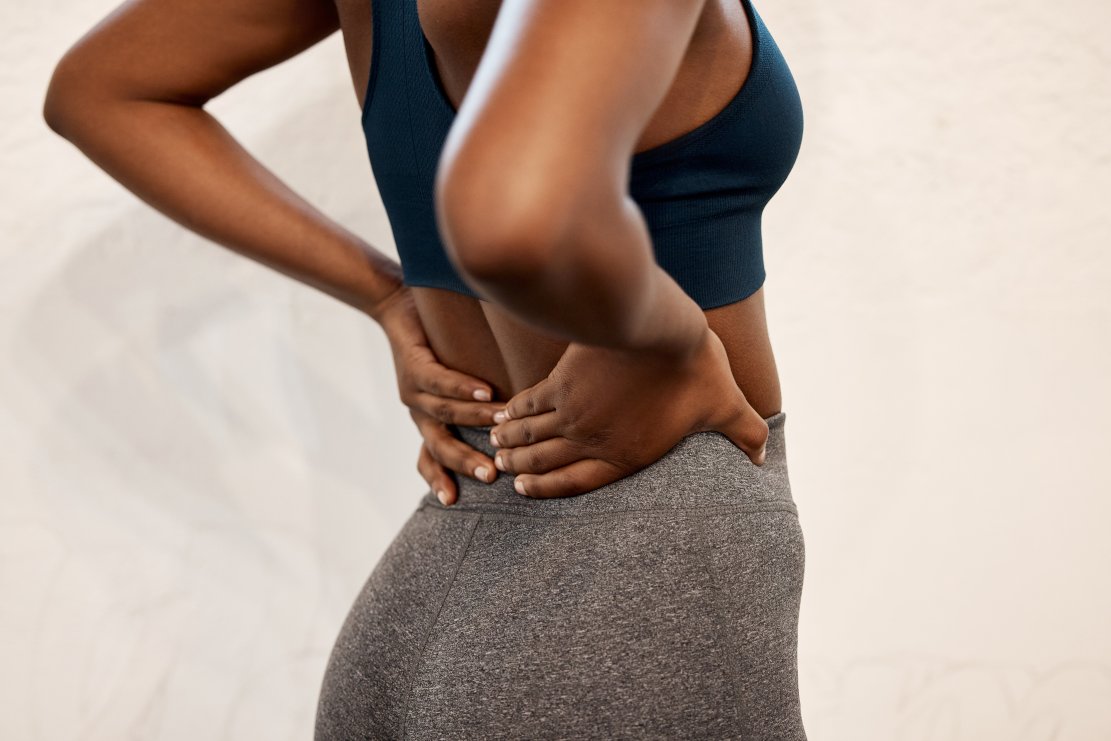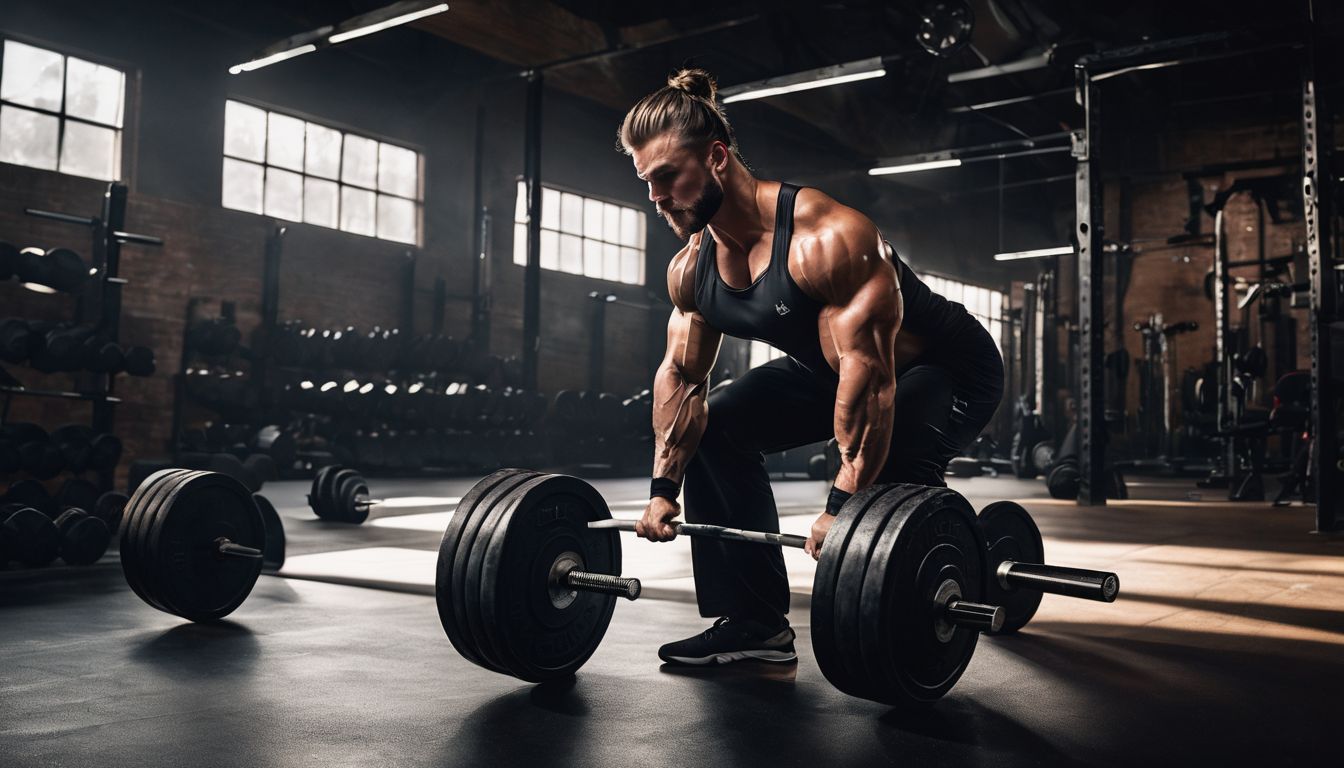
Experiencing lower back pain? You may be surprised to learn that your glute muscles could be contributing to the problem. This article will shed light on how weak or underactive glutes can lead to such discomfort and offer practical solutions for strengthening these crucial muscles.
Read on, your journey towards a pain-free life starts here!
Key Takeaways
- Weak glute muscles can contribute to lower back pain by causing biomechanical imbalances and instability in the pelvis and hips.
- Sedentary lifestyle, muscle imbalances, poor posture, and certain medical conditions can lead to weak or tight glutes.
- Strengthening exercises like the seated figure-four stretch, downward-facing dog, pigeon pose, knee to opposite shoulder, and standing figure-four stretch can help strengthen and stretch the glutes.
- Maintaining strong glutes is important for improving posture, gait, hip mobility, reducing muscle tension in the lower back area.
- Targeted exercises that can be done at home include squats, hip bridges, lunges, and using resistance bands.
Understanding the Glutes and their Role in Lower Back Pain
The glutes, or the muscles in our buttocks, play a crucial role in maintaining the stability and alignment of our lower back. Weak glutes can lead to improper movement patterns, muscle imbalances, and ultimately contribute to lower back pain.
Anatomy of the Glutes
The gluteal region of your body houses three primary muscles- the Gluteus Maximus, Gluteus Medius, and Gluteus Minimus. They form the shape of your buttocks and serve more purposes than just enhancing your physical appearance.
The largest one among them is the Gluteus Maximus that supports hip extension and rotation while standing or climbing stairs. Having a central role in maintaining balance, its strength decides how well you remain stable during movement.
Right above it lies the Gluteus Medius primarily responsible for hip abduction and internal rotation when you’re upright & stationary. This muscle prevents unwanted tilting of hips during single-leg activities such as walking or running.
Deeper still rests the smallest sibling, the Gluteus Minimus which aids our thighs’ inward motion while ensuring stability in our pelvis.
Furthermore, other smaller muscles like Piriformis also reside within this area which assist us to lift our upper legs away from body midline making everyday tasks like sitting down comfortably or stepping aside possible.
Underneath their aesthetic appeal thus exists a complex system working diligently to keep us moving smoothly with minimal discomfort!
How Weak Glutes can Cause Lower Back Pain
Weak glutes can be a major contributing factor to lower back pain. When the gluteal muscles are underactive or tight, it can lead to biomechanical imbalances in the pelvis and hips.
This instability puts strain on the lower spine, resulting in discomfort and pain. Chronic low back pain is often associated with weak glutes, specifically the gluteus medius muscle.
Over time, this weakness can worsen back pain and limit mobility. Strengthening the glutes through targeted exercises can help alleviate or prevent lower back pain by improving stability and supporting proper posture.
Common Causes of Glute Weakness and Tightness
Weakness and tightness in the glute muscles can occur due to a variety of reasons. One common cause is a sedentary lifestyle, where sitting for long periods weakens these muscles over time.
Another factor is muscle imbalances, such as overactive hip flexors and underactive glutes, which can lead to tightness and weakness in the butt muscles. Other causes include poor posture, lack of proper exercise or strength training for the glutes, and certain medical conditions like sciatica or piriformis syndrome.
Understanding these common causes can help individuals identify and address their own glute weaknesses and tightness to alleviate lower back pain. Strengthening exercises targeted at the glutes combined with stretching routines can provide relief by improving flexibility, range of motion, posture, and overall hip mobility while reducing muscle tension in the lower back area.
Strengthening and Stretching Exercises for the Glutes
To strengthen and stretch the glutes, try exercises such as the seated figure-four stretch, downward-facing dog, pigeon pose, knee to opposite shoulder, and standing figure-four stretch.
Seated Figure-Four Stretch
Performing the seated figure-four stretch can help improve flexibility and relieve tension in the glutes and hips, which can contribute to lower back pain. Start by sitting on a mat or chair with both feet flat on the floor.
Cross one ankle over the opposite knee, forming a figure-four shape with your legs. Gently press down on the raised knee until you feel a stretch in your glute muscles. Hold this position for 20-30 seconds, then switch sides and repeat.
Regularly incorporating this stretch into your routine can help alleviate muscle tightness and improve range of motion in your hips, ultimately reducing strain on your lower back muscles.
Downward-Facing Dog
Downward-Facing Dog is a popular yoga pose that can help strengthen the glutes and alleviate lower back pain. In this pose, you start on your hands and knees with your hands shoulder-width apart and knees hip-width apart.
Then, lift your hips up while straightening your legs, creating an inverted V shape with your body. While in this position, focus on engaging the glute muscles by pressing down through the palms of your hands and lifting through the hips.
This helps to activate and strengthen the glutes while also stretching out the hamstrings and calves.
Performing Downward-Facing Dog regularly can improve hip mobility, increase flexibility in the posterior chain (which includes the glutes), and enhance overall posture. It’s important to maintain proper alignment during this pose by keeping a slight bend in your knees if needed and ensuring that your head is aligned with your arms rather than dropping it between them.
Pigeon Pose
Pigeon Pose is a yoga posture that targets the gluteal muscles and can help improve flexibility and range of motion in the hips. By stretching and strengthening these muscles, Pigeon Pose can alleviate lower back pain caused by weak or tight glutes.
This pose specifically targets the piriformis muscle, which lies deep within the buttocks and can contribute to lower back discomfort when it becomes overactive or tense. Regular practice of Pigeon Pose can help create balance in the hip muscles, improving overall stability and posture while reducing strain on the lower back.
Knee to Opposite Shoulder
Performing the knee to opposite shoulder exercise can help strengthen your gluteal muscles and alleviate lower back pain. Start by lying flat on your back with your legs extended. Bend one knee, bringing it towards your chest.
Then, use your hands to gently pull the knee across your body towards the opposite shoulder. Hold this stretch for 20-30 seconds before returning to the starting position and repeating on the other side.
This exercise helps improve hip mobility, increase flexibility in the glutes and hips, and relieve muscle tension in the lower back. Strengthening these muscles can contribute to better posture and reduce lower back pain over time.
Standing Figure-Four Stretch
The standing figure-four stretch is a great exercise to help strengthen and stretch the glutes, which can be beneficial for lower back pain. To perform this stretch, stand tall with your feet hip-width apart.
Cross one ankle over the opposite knee, forming a “figure-four” shape with your legs. Gently lower your hips down as if you’re sitting back into a chair while keeping your back straight.
You should feel a gentle stretch in the glute muscles of the crossed leg. Hold this position for 20-30 seconds and then switch sides. This stretch helps increase flexibility and range of motion in the hips, relieving tension in the lower back muscles.
The Importance of Maintaining Strong Glutes for Lower Back Health
Maintaining strong glutes is crucial for lower back health as weak glutes can lead to muscle imbalances, poor posture, and altered movement patterns.
Effects of Glute Weakness on Posture and Gait
Weak glute muscles can have a significant impact on posture and gait. When the glutes are weak, it can lead to muscle imbalances in the lower back, pelvis, and hips, causing instability in the spine.
This can result in poor posture and altered movement patterns while walking or running. Additionally, weak glutes can affect hip mobility and range of motion, leading to compensatory movements that put extra strain on other muscles and joints.
Strengthening the glutes through targeted exercises is essential for improving both posture and gait, reducing the risk of lower back pain, and enhancing overall body mechanics.
How to Strengthen Glutes at Home
Strengthening your glutes at home is not only convenient but also essential for maintaining a strong and stable lower back. There are several effective exercises that you can incorporate into your routine to target these muscles.
One option is the classic squat, which works the glutes along with other leg muscles. Another great exercise is the hip bridge, where you lie on your back with knees bent and lift your hips off the ground.
Lunges are also effective in engaging the glute muscles. Additionally, don’t forget about resistance bands – they can add an extra challenge to your workouts and help build strength in your glutes.
Conclusion
Weak back glute muscles can have a significant influence on lower back pain. When these muscles are underactive or tight, it can lead to instability in the pelvis and hips, causing biomechanical imbalances that contribute to pain in the lower spine.
Strengthening the glutes is crucial for reducing low back pain disability and improving overall function. Don’t let weak glutes hold you back from a healthy, pain-free back!
FAQs
1. What is the connection between weak back glute muscles and lower back pain?
Weak back glute muscles can cause an imbalance in the hip joint, leading to stress on the lumbar spine resulting in lower back pain.
2. How do pelvic and core muscles influence lower back pain?
Pelvic and core muscles support the spinal muscles; when these are weak, it puts extra pressure on your lower spine causing discomfort and pain.
3. Can strengthening my glutes help alleviate my lower back pain?
Yes! Stronger glutes provide better support for your hip joint which reduces strain on your lumbar area, thus helping to lessen or even eliminate lower back pain.
4. What exercises can I do to strengthen my weak back-glute muscles?
There are several exercises you can try to improve muscle strength like squats, lunges, bridges or even yoga poses focused on pelvic and posterior chain strength.



